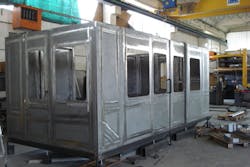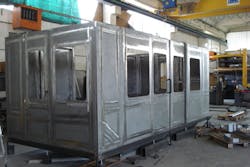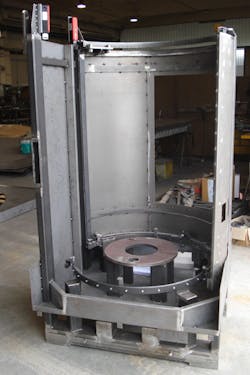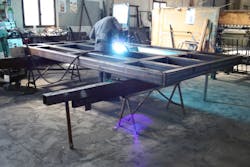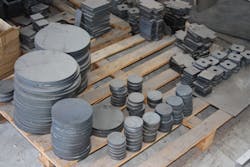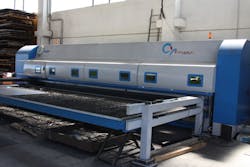Laser cutting helps company survive the recession
by Antonio Vendramini
At the recent Lamiera 2012 (an Italian fabrication trade show held in Bologna annually), I met the owner of a modest-sized fabrication shop Ambrosio Carbone, who said to me, "Had I not had a laser system, my company would be in big trouble now." I arranged to visit with him at the company Officine e Costruzioni Carbone, located in Gazzola (Piacenza), Italy.
Prior to the meeting, that phrase "Had I not had a laser ..." was frequently in my head, and I tried to imagine the situation that prompted it. It was difficult to imagine when the laser cutting system had been purchased in order for it to be so gratifying. If the system had been acquired long before the recent crisis (say autumn 2008), then Carbone's company would have enjoyed a good stretch of economic upturn as Italy's manufacturing economy was strong, and laser services were booming; 2007 and good part of 2008 were very good growth years for lasers in Italy. However, if the purchase had been made at the beginning of the recession or thereafter, it is hard to imagine how it could have been a lifeline for the company. My only recourse was to wait for the meeting.
Current situation
Ambrosio Carbone describes the origin of the company: "The company was founded some 60 years ago by my father to repair farm equipment and vehicles that were and still are commonly utilized in the area. For nearly 20 years, after my brother and I became active in the company, the Officine e Costruzioni Carbone company was a fabrication shop as well, building semi-finished products for neighboring machine tool builders. The problem started in 2007, during the booming years of laser processing. For years, we operated successfully with a 12-station indexing punching machine, but increasingly customers were asking us for laser processing."
What are the reasons for this, he is asked, taking into account the quality obtainable with a good punch? Mr. Carbone replies: "With our punch we were able to meet a large part of our customer's requests, but an increasing number of them demanded laser cut quality -- and we recognized that this was what they wanted, even if, from a functional point of view, laser cuts were not necessary. To solve this problem we selected one of the many laser cutting service shops in the area and began outsourcing a fair amount of work. At the time, my brother and I thought that our company could not afford and or efficiently manage a CO2 laser system, due to the operating costs and maintenance associated with it. At the same time, we discovered certain manufacturing advantages compared to the punched parts; we could save all the finishing operations of punched burr removal. In addition, by observing the operation of these systems, we became attracted to the idea of being able to use a system with a large working area and avoid the expensive equipment for loading / unloading of the components."
The decision to purchase
What happened in early 2008 to make him change his mind? Mr. Carbone says, "We had never directly pursued laser technology, even though we were often approached by laser machine builders, which normally happens with a small company. However we began to look for an innovative machine with lower costs of operation. In early 2008, we met the local sales representative of Cy Laser, and he showed us a laser cutting system that utilized a fiber laser generator as opposed to a CO2 resonator. We were aware of this new laser solution but, as often can happen; we never had time to learn about it in detail. What impressed us the most were two things: the run costs of this solution were really reduced, and it was not an issue for the optics to operate on a work table as large as 6 × 2 meters. The beam delivery in fact is performed through a fiber optic cable (the size of fishing line) and even 6 meters (or more) away from the generator, the laser beam does not change or lose power, it stays constant over time.
"Relative to run costs, we requested that Cy Laser provide a written cost estimate that they guaranteed," Carbone continues. "Table size, system uptime, and sheet scrap optimization were benefits, and we knew that in our geographical area, a large table would position us competitively as we would be the first in the area."
In the beginning of 2008, when the market for laser cutting systems in Italy took off, the company purchased a cutting system with a 2 kW fiber laser, 2 × 6 meters cutting area, and dual tables from the Italian company Cy Laser. Carbone says, "The companies close to us in the laser cutting sector told us we were making a mistake. According to them, the future of laser cutting was still with CO2 laser sources that had demonstrated over the years their operational efficiency."
Development
In June 2008, Officine e Costruzioni Carbone took delivery of its new Cy Laser system. Carbone continues, "We already were familiar with the nesting software and programming. After two days, we were already in operation. We did not think it would be so easy to work with a laser system and, more importantly, did not expect to use it as much as we have over the years.
He is asked, despite the recession years in Europe and in Italy, if the company used the laser a lot. Carbone replies: "With laser cutting within the company, we in-sourced all the work that was previously done outside; this recouped the higher cost of outsourcing."
At this point, we ask about the cost. Carbone tells us: "There are no secrets, at the time of the system purchase, we were told that the hourly cost of its use was only a few Euros / hour (not tens of Euros); today, four years later, I can say that the cost of its maintenance has not been more than 1500 Euros / year (approx. $2000). We did have a repair on the cutting head in addition to that, but the damage was caused by an error on our part. We never had problems with the beam delivery optical fiber, and we changed one focal lens." Surprised by this data, we ask the number of hours the laser is worked each day, on average. "Like all small businesses, we operate on a long shift, and in the evening, we plan to cut thick plate, unattended, for many hours of the night. On average, we can say that our system has worked for over 3200 hours / year."
We ask Carbone how he lived through the years of global crisis, particularly in Italy. His answer helps explain the title of this article. "First, I must repeat that our purchase of a fiber laser cutting system allowed us to bring in-house all the work outsourced, saving a lot of money, as our supplier was utilizing a CO2 cutting system, which is substantially more expensive to run and maintain. I must also note that for many years we had progressively evolved from simple contractors to fabricators, and currently over 90% of our work time is devoted to the production of finished components."
Mr. Carbone continues: "I must say that the in-house availability of a laser cutter has allowed us to improve our work, finding better solutions to assemble more easily and more profitably the components that go into our final assemblies. With the use of external suppliers, this was not possible and we often had to compromise. In this way, we were able to contain the prices of our work as required by the market, but at the same time increasing our revenues through new orders, even at several older accounts."
We asked Mr. Carbone if he could share with us some information about his company's growth. "It's simple. In 2008, we were a nine-person company; today we have 13 workers, and the annual sales increased by 85% -- thanks to the laser."
Italian company Cy Laser, has a working range of 6 × 2 m.
Dr. Antonio Vendramini ([email protected]) is a laser consultant. His company , Lasertec s.a.s, is located in Segrate, Italy. He is a frequent contributor to his own publication, Applicazioni Laser.
